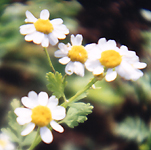The information on this page compiled by
IntroductionFeverfew has a history of use for fever, migraines, arthritis, earache, dysmenorrhea and gastrointestinal upset. It has been studied as an effective preventative for migraines, reducing their frequency and severity.
[ Back to the Index. ]
[ Back to the Index. ]
[ Back to the Index. ]
[ Back to the Index. ]
[ Back to the Index. ]
[ Back to the Index. ]
[ Back to the Index. ]
[ Back to the Index. ]
[ Back to the Index. ]
[ Back to the Index. ]
2. Williams CA et al, A biologically active lipophilic flavonol from
Tanacetum parthenium, Phytochemistry 1995; 38(1):267-70
3. Platelet aggregation inhibition. Groenewegen WA et al, A comparison
of the effects of an extract of feverfew and parthenolide, a component
of feverfew, on human platelet activity in-vitro, J Pharm Phamacol 1990;42(8):553-7
4. Murphy JJ et al, Randomized double-blind placebo-controlled trial
of feverfew in migraine prevention, Lancet 1988;2(8604):189-92
5. Johnson ES et al, Efficacy of feverfew as prophylactic treatment
of migraine, Br Med J 1985;291(6495):569-73
6. Composite allergy. Goulden V et al, Patch testing for Compositae
allergy, Br J Dermatol 1998;138(6):1018-21
7. Miller LG, Herbal medicinals: selected clinical considerations focusing
on known or potential drug-herb interactions, Arch Intern Med 1998;158(20):
2200-11
[ Back to the Index. ]
* The information presented in this web site is intended to inform and educate.
It is not intended replace a qualified medical practitioner to diagnose or treat medical conditions.
|
|
| [ Treatments | Site Directory | Home ]
|
||||||||

